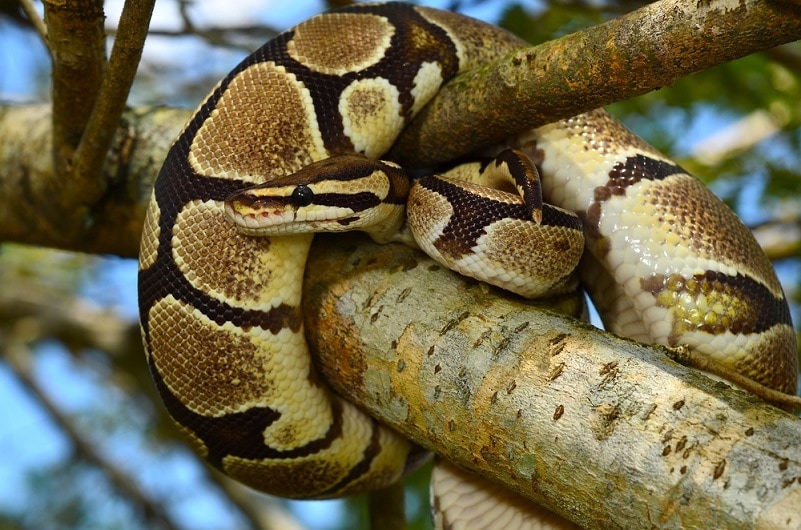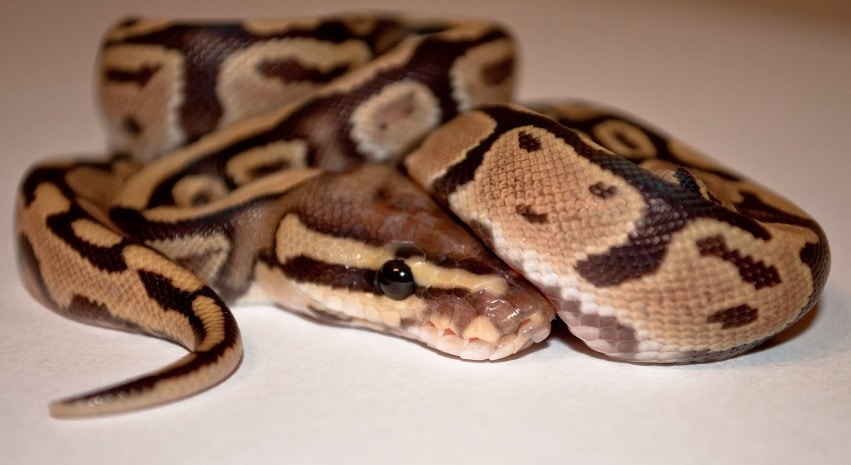

Ball pythons are the top favorites of many reptile enthusiasts because they are easy to keep and have gentle demeanors. Ball pythons also offer some of the world’s coolest morphs, coming in about any color or pattern you can imagine—like the fire ball.
If you caught a glimpse of the fire ball ball python morph, you’re probably determined to learn all you can. So, let’s go over all the basic information you need about this popular morph.

Quick Facts About Fire Ball Python Morphs

| Species Name: | Python regius |
| Common Name: | Fire Ball Python |
| Care Level: | Beginner |
| Lifespan: | 25-30 years |
| Adult Size: | 3-5 feet |
| Diet: | Carnivore |
| Minimum Tank Size: | 30-50 gallons |
| Temperature: | 75-92 degrees Fahrenheit |
| Humidity: | 50%-60% |
Do Fire Ball Python Morphs Make Good Pets?
Ball pythons are native to central and western parts of Africa, where they dwell in humid, toasty temperatures. These snakes have made their way into homes all over, charming snake lovers with their calm nature and incredible breeding potential.
The fire ball python is a specific morph that makes excellent additions to any reptile collection. They are generally slow-moving and don’t mind being handled. Because they’re laid back and unlikely to bite, they work well for first-timers or younger owners.
Appearance
The fire ball python is a codominant morph that is intricately patterned, typically banded with satiny gold and black. But in some, you can find diluted or bold coloring, depending on the genetics and the pairing.
Each pattern is specific to the snake, but they all share black eyes. There are many different forms of the fire ball. If a fire mates with any other ball python, they make fire offspring. However, two fires make super fire ball pythons.
Super forms of the fire ball python are called the black-eyed leucistic, which is ultra-light and sometimes blotchy in color

How to Take Care of a Fire Ball Python Morph
Because fires are cold-blooded creatures that require a life much different from your own, you need to gather up the supplies beforehand. These guys need heating pads, basking lamps, and proper substrate to thrive.
Habitat, Tank Conditions & Setup
Tank
Adult fire ball pythons should live in entirely glass enclosures that are at least 30 gallons. For larger fires, you should increase the size of the tank by 10 gallons.
Your ball python might not be the most active snake, but they still enjoy having space to move around. These snakes work well in all enclosures with long branches so they can climb at will.
The more space you can provide, the more at home your snake will feel.
Décor
Ball pythons love having places to climb, hide, and bask. Make sure to fill the tank full of hides, branches, and foliage (if you can).
Lighting
Your fire ball python will need light cycles that mimic daytime and nighttime in nature. Though these snakes don’t require UVB light like some reptiles, they do benefit from low-level UVB light.
You should leave the light on for 12 hours per day.
Heating (Temperature & Humidity)
Because snakes are cold-blooded, they require adequate heat. They need a basking spot where they can absorb a large amount of heat. It should stay within the 88 to 92-degree F region. The rest of the cage can stay between 75 to 85 degrees F.
Humidity levels should stay between 50% and 60%. Your fire absolutely needs these levels at all times so that they can shed properly and prevent scale drying. Since they live in such hot temperatures, adding some mist is crucial to keep things moist.
Substrate
Ball pythons require a substrate that retains moisture to keep their skin supple. In warm environments with dry materials, it can irritate and dry out scales.
The best substrates for fire ball pythons includes:
- Cypress mulch
- Reptile bark
- Coconut husk
Try to avoid substrates like:
- Pine shavings
- Cedar chips
- Recycled paper bedding
- Sand
Tank Recommendations
| Tank Type | 30-gallon glass tank |
| Lighting | Low-level UVB light |
| Heating | Heating pad, basking lamp |
| Best Substrate | Reptile bark, coconut husk, cypress mulch |

Feeding Your Fire Ball Python Morph
Fire ball pythons have a very straightforward, inexpensive diet. They are one of the cheapest pets to feed, especially as juveniles.
When it comes to the menu, these ball pythons need rodents—from pinkies to full-grown rats—depending on their life stage.
Young ball pythons should start eating pinkies initially, increasing to fuzzies as they grow. Mature fire balls should eat mice or rats according to their size.
Juveniles should eat two times per week, and you should split up the feedings on equal days. Adults need one meal every one to two weeks. You can feed according to what works for their appetite.
Diet Summary
| Fruits | 0% of diet |
| Insects | 0% of diet |
| Meat | 100% of diet – small/ medium-sized rodents |
| Supplements Required | N/A |

Keeping Your Fire Ball Python Morph Healthy
Fire ball pythons are relatively low maintenance pets, so you shouldn’t run into many health issues as long as you provide proper care. However, that doesn’t mean your snake won’t face any issues. Reptiles can develop numerous health problems.
That is why it is of utmost importance to locate an exotic vet near you before committing to a purchase. Without proper professional care, your snake’s life span might not be as long, which is avoidable in many cases.
Common Health Issues
Here is a quick list of health problems your fire ball python might face:
- Stomatitis—a bacterial infection of the jawbone
- Mites—parasitic scale infestation
- Upper respiratory infections—infections of the lungs and airways
- Inclusion body disease—a viral infection of the lungs
Like many snakes, fires only show symptoms when sickness is already quite advanced. If you notice anything out of the ordinary, immediate vet attention is necessary.
Lifespan
A ball python that is completely healthy with no existing complications can live up to 30 years. These long lives require a big commitment, opposed to dogs or cats who live roughly 15 years.
However, many snake hobbyists do sell or trade their snakes for other morphs or species. Since reptiles don’t form emotional bonds with people, rehoming to proper owners is entirely possible.
Breeding
Ball pythons have tremendously long reproductive spans, lasting up to 30 years in some cases. The breeding season is generally from September to November.
Fire ball pythons lay clutches with six eggs on average, which stick together for protection. Incubators need to stay at 89 degrees F for successful hatching. Eggs will hatch between 50 to 55 days.

Are Fire Ball Python Morphs Friendly? Our Handling Advice
Fire ball pythons are incredibly docile creatures that are easy to handle. It would be best if you never made fast movements. Your snake can spook while they’re out, as this can lead to fear-biting.
However, if you calmly handle this snake, they will curiously explore you and the surrounding areas. Always make sure that you have your snake in a space they cannot escape. If there are any tiny areas or objects they could weasel into, beware.
These snakes can slip away or latch onto something pretty quickly. Monitor any out-of-the-enclosure experiences closely. Also, because of the risk of salmonella, always make sure to wash your hands once you finish.
Shedding & Brumation: What to Expect
Fire ball pythons shed their skin every 4-6 weeks. During the process, you might notice a white layer of film on their body. This is dead skin lifting from the newly emerging scales.
Ball pythons should shed in one or two pieces. It shouldn’t come off small flakes over time. If you think your ball python is having issues shedding due to improper humidity levels, you can soak them in water for 2 hours to help moisturize the skin.
Ball pythons do not enter brumation periods, meaning they do not require periods of hibernation—like some reptiles. However, during the winter months, their eating habits might slow down.
How Much Do Fire Ball Python Morphs Cost?
Since fire ball pythons are such a common morph, you will find that they are pretty affordable. Adults will be more valuable than juveniles, so they are at the higher end of the price spectrum.
On average, a fire ball python costs between $50 and $300, depending on breeder rates, the area you live, and the snake’s life stage. In comparison to some other morphs, this is a modest price.
But that’s not all—on top of that, you need to consider any supplies you need.
| Enclosure: | $50 – $350+ |
| Substrate: | $20 – $25 per month |
| Tank décor: | $20 – $30 |
| Mice/Rats: | $1 to $3 per rodent (frozen) |
| Thermometer: | $2-$5 |
| Hydrometer: | $2-$5 |
Of course, you can always cut costs by buying a snake with all-included supplies. You can also reuse an old enclosure or raise your own live feed.
Care Guide Summary
Fire Ball Python Pros
- Docile nature
- Easy handling
- Simple diet
Fire Ball Python Cons
- Must be housed individually
- Can grow quite large
- Often hide sickness until advanced

Conclusion
If you think that a fire ball python is your next reptile pet, check for options around you. Fire balls are plentiful, so you can find one by browsing online or visiting local pet shops. You might even find one from an owner ready to part with their pet.
Always make sure to keep humidity levels, temperature settings, and feeding schedules on par to keep your reptile healthy. Exotic vets are your best friend—go to them for any troubles your snake might have.
Featured Image Credit: Ery Azmeer, Shutterstock

Ashley Bates is a freelance dog writer and pet enthusiast who is currently studying the art of animal therapy. A mother to four human children— and 23 furry and feathery kids, too – Ashley volunteers at local shelters, advocates for animal well-being, and rescues every creature she finds. Her mission is to create awareness, education, and entertainment about pets to prevent homelessness. Her specialties are cats and dogs.





